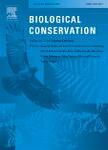版权所有:内蒙古大学图书馆 技术提供:维普资讯• 智图
内蒙古自治区呼和浩特市赛罕区大学西街235号 邮编: 010021

作者机构:Texas A&M Univ Interdisciplinary PhD Program Ecol & Evolutionary MS 2475 College Stn MS 77843 USA Texas State Univ Dept Biol 601 Univ Dr San Marcos TX 78666 USA Texas A&M Univ Dept Ecol & Conservat Biol MS 2258 College Stn MS 77843 USA
出 版 物:《BIOLOGICAL CONSERVATION》 (生物保护)
年 卷 期:2021年第257卷
页 面:109143-109143页
核心收录:
学科分类:0710[理学-生物学] 0830[工学-环境科学与工程(可授工学、理学、农学学位)] 07[理学] 09[农学] 0713[理学-生态学]
基 金:American Society of Mammalogists Natural History Museum of Los Angeles County EEB program at Texas AM University USDA NIFA Hatch [TEX09600, 1020451, TEX 019344, 1003569]
主 题:Captive breeding Cranial morphology Geometric morphometrics Carnivora Canidae
摘 要:Hypercarnivorous mammal species are among the most vulnerable to population losses and endangerment. Among species belonging to Family Canidae, hypercarnivores are frequently subject to intense conservation efforts including captive breeding and reintroduction attempts. However, hypercarnivorous species may be most vulnerable to morphological changes in captivity, potentially altering their cranial functionality and limiting their reintroduction success. Other canid species with varying dietary preferences are also maintained in captivity, although it is unknown if morphological changes are prevalent across all captive canid populations or if these changes are concentrated primarily within hypercarnivores. To examine whether canids display morphological changes in captivity regardless of dietary preference, we assessed cranial and mandibular shape of 1621 specimens representing 15 canid species using geometric morphometric techniques. All hypercarnivores (4 species) and many hypocarnivores (5 of 7 species) differed between captive and wild populations in at least one shape variable. None of the mesocarnivores (4 species) differed in any shape variable. Among the carnivory types, hypercarnivorous species had the most pronounced differences in shape, particularly associated with a widening and shortening of the cranium within captive populations. Changes in cranial shape may impact an animal s ability to successfully capture and consume prey, therefore differences in cranial shape in captive populations may represent an obstacle to future reintroduction success. By examining cranial and mandibular shape differences between captive and wild populations, we explore the long-term impacts of captivity in canids in an effort to mitigate these negative effects in the future and increase the potential for reintroduction success.